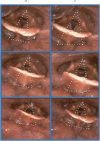Domiciliary use of transcutaneous electrical stimulation for patients with obstructive sleep apnoea: a conceptual framework for the TESLA home programme
- PMID: 31285910
- PMCID: PMC6588784
- DOI: 10.21037/jtd.2019.05.04
Domiciliary use of transcutaneous electrical stimulation for patients with obstructive sleep apnoea: a conceptual framework for the TESLA home programme
Abstract
Obstructive sleep apnoea (OSA) is a global health problem of increasing prevalence. Effective treatments are available with continuous positive airway pressure (CPAP) therapy and mandibular advancement devices (MAD). However, there is limited long-term adherence to therapy, as CPAP and MAD require permanent usage to avoid recurrence of the symptoms and adverse ill health. Alternative treatments would aid in the treatment cascade to manage OSA effectively whenever standard therapy has been trialled and failed. Hypoglossal nerve stimulation (HNS), an invasive approach to stimulate the pharyngeal dilator muscles of the upper airway during sleep, has been approved for the treatment of OSA by several healthcare systems in recent years. In parallel to the development of HNS, a non-invasive approach has been developed to deliver electrical stimulation. Transcutaneous electrical stimulation in obstructive sleep apnoea (TESLA) uses non-invasive electrical stimulation to increase neuromuscular tone of the upper airway dilator muscles of patients with OSA during sleep. Data from previous feasibility studies and randomised controlled trials have helped to identify a subgroup of patients who are "responders" to this treatment. However, further investigations are required to assess usability, functionality and task accomplishment of this novel treatment. Consideration of these factors in the study design of future clinical trials will strengthen research methodology and protocols, improve patient related outcome measures and assessments, to optimise this emerging therapeutical option. In this review, we will introduce a conceptual framework for the TESLA home programme highlighting qualitative aspects and outcomes.
Keywords: Hypoglossal nerve stimulation (HNS); compliance; continuous positive airway pressure (CPAP); neural stimulation; sleepiness.
Conflict of interest statement
Conflicts of Interest: J Steier is named inventor on patent WO 2016/124739 Al (‘Apparatus for treatment of snoring and sleep apnoea’) on behalf of King’s College London and Guy’s & St Thomas’ NHS Foundation Trust. Other authors have no conflicts of interest to declare.
Figures




Similar articles
-
Beyond Usual Care: A Multidisciplinary Approach Towards the Treatment of Obstructive Sleep Apnoea.Front Cardiovasc Med. 2022 Jan 5;8:747495. doi: 10.3389/fcvm.2021.747495. eCollection 2021. Front Cardiovasc Med. 2022. PMID: 35071340 Free PMC article. Review.
-
Domiciliary transcutaneous electrical stimulation in patients with obstructive sleep apnoea and limited adherence to continuous positive airway pressure therapy: a single-centre, open-label, randomised, controlled phase III trial.EClinicalMedicine. 2023 Aug 3;62:102112. doi: 10.1016/j.eclinm.2023.102112. eCollection 2023 Aug. EClinicalMedicine. 2023. PMID: 37654667 Free PMC article.
-
Transcutaneous electrical stimulation in obstructive sleep apnoea: current developments and concepts of the TESLA-home programme.Curr Opin Pulm Med. 2022 Nov 1;28(6):529-536. doi: 10.1097/MCP.0000000000000910. Epub 2022 Aug 22. Curr Opin Pulm Med. 2022. PMID: 35993267 Review.
-
Emerging technology: electrical stimulation in obstructive sleep apnoea.J Thorac Dis. 2015 Aug;7(8):1286-97. doi: 10.3978/j.issn.2072-1439.2014.04.04. J Thorac Dis. 2015. PMID: 26380757 Free PMC article. Review.
-
Patients' preference of established and emerging treatment options for obstructive sleep apnoea.J Thorac Dis. 2015 May;7(5):938-42. doi: 10.3978/j.issn.2072-1439.2015.04.53. J Thorac Dis. 2015. PMID: 26101652 Free PMC article.
Cited by
-
Beyond CPAP: modifying upper airway output for the treatment of OSA.Front Neurol. 2023 Jul 21;14:1202271. doi: 10.3389/fneur.2023.1202271. eCollection 2023. Front Neurol. 2023. PMID: 37545734 Free PMC article. Review.
-
Current and novel treatment options for obstructive sleep apnoea.ERJ Open Res. 2022 Jun 27;8(2):00126-2022. doi: 10.1183/23120541.00126-2022. eCollection 2022 Apr. ERJ Open Res. 2022. PMID: 35769417 Free PMC article. Review.
-
Hypoglossal Nerve Stimulation in the Treatment of Obstructive Sleep Apnea: Patient Selection and New Perspectives.Nat Sci Sleep. 2020 Feb 13;12:151-159. doi: 10.2147/NSS.S221542. eCollection 2020. Nat Sci Sleep. 2020. PMID: 32104122 Free PMC article. Review.
-
Beyond Usual Care: A Multidisciplinary Approach Towards the Treatment of Obstructive Sleep Apnoea.Front Cardiovasc Med. 2022 Jan 5;8:747495. doi: 10.3389/fcvm.2021.747495. eCollection 2021. Front Cardiovasc Med. 2022. PMID: 35071340 Free PMC article. Review.
-
Pathophysiological mechanisms and therapeutic approaches in obstructive sleep apnea syndrome.Signal Transduct Target Ther. 2023 May 25;8(1):218. doi: 10.1038/s41392-023-01496-3. Signal Transduct Target Ther. 2023. PMID: 37230968 Free PMC article. Review.
References
Publication types
LinkOut - more resources
Full Text Sources
Other Literature Sources
